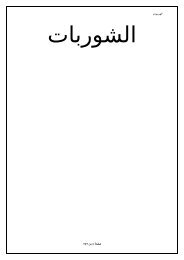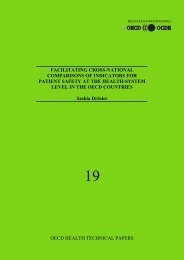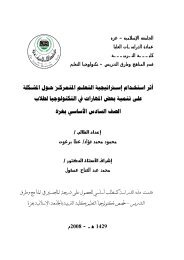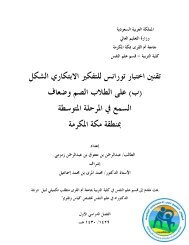Joint angle parameters in gait: Reference data for normal subjects ...
Joint angle parameters in gait: Reference data for normal subjects ...
Joint angle parameters in gait: Reference data for normal subjects ...
- No tags were found...
You also want an ePaper? Increase the reach of your titles
YUMPU automatically turns print PDFs into web optimized ePapers that Google loves.
WDepartment ofVeterans AffairsJournal of Rehabilitation Research andDevelopment Vol . 31 No. 3, August 1994Pages 199—213<strong>Jo<strong>in</strong>t</strong> <strong>angle</strong> <strong>parameters</strong> <strong>in</strong> <strong>gait</strong> : <strong>Reference</strong> <strong>data</strong> <strong>for</strong> <strong>normal</strong><strong>subjects</strong>, 10-79 years of ageTommy Oberg, MD, PhD ; Alek Karsznia, PT, PhD : Kurt Oberg, PhDDepartment of Biomechanics and Orthopaedic Technology, University College of Health Sciences, S-551 11Jonkop<strong>in</strong>g, Sweden; Department of Agricultural Eng<strong>in</strong>eer<strong>in</strong>g, Swedish University of Agricultural Sciences,S-750 07 Uppsala, SwedenAbstract—In the laboratory, <strong>gait</strong> analysis is often completedwith goniometry . In a previous article (Journal ofRehabilitation Research and Development, Vol. 30 No.2), reference <strong>data</strong> <strong>for</strong> basic <strong>gait</strong> <strong>parameters</strong> were presented. The aim of this study was to provide suchreference <strong>data</strong> <strong>for</strong> jo<strong>in</strong>t <strong>angle</strong> <strong>parameters</strong> . Two hundredand thirty-three healthy <strong>subjects</strong> (116 men and 117women) 10-79 years of age, were entered <strong>in</strong>to the study.The measurements were made <strong>in</strong> a <strong>gait</strong> laboratory withelectrogoniometers with Lamoreaux type of exoskeleton.A series of reference tables <strong>for</strong> slow, <strong>normal</strong> and fastspeed are presented . Means, standard deviations, coefficientsof variation, 95% confidence <strong>in</strong>tervals, and 95%prediction <strong>in</strong>tervals were calculated . We found m<strong>in</strong>orchanges with age, no differences between right and leftside, significant sex differences, and significant changeswith <strong>in</strong>creas<strong>in</strong>g <strong>gait</strong> speed . The reference <strong>data</strong> areconsidered valid <strong>in</strong> an <strong>in</strong>door laboratory situation . If <strong>gait</strong>analysis is used <strong>for</strong> evaluation of disabled people, acomparison must be made with <strong>data</strong> from healthy people.This study provides such normative <strong>data</strong> <strong>for</strong> jo<strong>in</strong>t <strong>angle</strong><strong>parameters</strong>.Address all correspondence and requests <strong>for</strong> repr<strong>in</strong>ts to : Tommy Oberg,MD, PhD, Director, Department of Biomechanics and OrthopaedicTechnology, University College of Health Sciences, S551 11 Jonkop<strong>in</strong>g,Sweden.Dr. T. Oberg and Dr. A. Karsznia are associated with the UniversityCollege of Health Sciences <strong>in</strong> Jonkop<strong>in</strong>g ; Dr. K. Oberg is associatedwith both the University College of Health Sciences and the SwedishUniversity of Agricultural Sciences .Key words : <strong>gait</strong> analysis, goniometry, jo<strong>in</strong>t <strong>angle</strong>s,reference <strong>data</strong>.INTRODUCTIONThe basic <strong>gait</strong> <strong>parameters</strong> are <strong>gait</strong> speed, steplength, and step frequency. In a previous article,reference <strong>data</strong> of such <strong>parameters</strong> were presented<strong>for</strong> men and women, aged 10-79 years (1). Suchreference <strong>data</strong> are important <strong>in</strong> all <strong>gait</strong> analysis.However, <strong>in</strong> the laboratory <strong>gait</strong> analysis often<strong>in</strong>cludes goniometry (i .e., measurement of jo<strong>in</strong>t<strong>angle</strong>s); there<strong>for</strong>e, there is also a need <strong>for</strong> reference<strong>data</strong> <strong>for</strong> such measurements . In this article, wepresent reference <strong>data</strong> on hip and knee motion <strong>for</strong>men and women of different ages.Electrogoniometry represents a simple and reliablemethod <strong>for</strong> measur<strong>in</strong>g jo<strong>in</strong>t motion dur<strong>in</strong>g <strong>gait</strong>(2-5) . The most frequent methods of present<strong>in</strong>gsuch <strong>data</strong> are as figures of total jo<strong>in</strong>t excursiondur<strong>in</strong>g <strong>gait</strong> (3,6-9), as a plot of jo<strong>in</strong>t <strong>angle</strong> aga<strong>in</strong>sttime (10), or as <strong>angle</strong>/<strong>angle</strong> diagrams (11-13).Goniometer measurements have been reportedfrom studies of men (2-4,6-8), and women (3,9,14).Age effects on jo<strong>in</strong>t excursions dur<strong>in</strong>g <strong>gait</strong> have alsobeen studied by several authors (6-10,14) . However,most of these studies have been done on smallnumbers of <strong>subjects</strong>, and cannot be used as reference<strong>data</strong>. The aim of this study was to present ageand sex specific jo<strong>in</strong>t <strong>angle</strong> <strong>data</strong> obta<strong>in</strong>ed dur<strong>in</strong>g <strong>gait</strong>analysis.199
202Journal of Rehabilitation Research and Development Vol . 31 No. 3 1994Table 3a.<strong>Jo<strong>in</strong>t</strong> <strong>angle</strong>s . Changes with age . Women (N = 117) . Slow <strong>gait</strong>.One-way ANOVARegression analysisVariable F-value p-value Change t-value p-valuedf= 7degreesper decadeRight knee, midstance 0.85 N.S . +0.4 1 .65 N.S.Left knee, midstance 1 .47 N.S . +0 .3 1 .54 N.S.Right knee, sw<strong>in</strong>g 2.29 p< 0.05 - 0 .7 - 2.52 p< 0.05Left knee, sw<strong>in</strong>g 3 .28 p < 0 .01 - 0 .9 - 3 .29 p
203OBERG et al. <strong>Jo<strong>in</strong>t</strong> Angle Parameters of GaitTable 4a.<strong>Jo<strong>in</strong>t</strong> <strong>angle</strong>s . Z-Test <strong>for</strong> side difference. Men (N = 116)and Women (N = 117) . Slow <strong>gait</strong> .Table 5a.<strong>Jo<strong>in</strong>t</strong> <strong>angle</strong>s. Test <strong>for</strong> sex differences. Men (N = 116) andWomen (N = 117) . Z-test. Slow <strong>gait</strong>.Variable Sex z-value p-value Variable z-value p-valueKnee, midstance M 0 .31 N .S . Right knee, midstance 7.46 p
204Journal of Rehabilitation Research and Development Vol . 31 No. 3 1994ters is also shown <strong>in</strong> a series of regression diagrams(Figures 1 a,b, 2 a,b, and 3 a,b) . There were almostno side differences.50Y=1 .3+0.136X40<strong>Reference</strong> Data (Appendix)<strong>Reference</strong> <strong>data</strong> are shown <strong>in</strong> the Appendix asjo<strong>in</strong>t <strong>angle</strong>s at slow, <strong>normal</strong>, and fast <strong>gait</strong> speed <strong>for</strong> omen and women respectively (Tables 1 a-b, 2 a-b, a 30and 3 a-b) . Means, standard deviations (SD), coefficientsof variation, 95 percent confidence <strong>in</strong>tervalsand 95 percent prediction <strong>in</strong>tervals have been calculated.In our op<strong>in</strong>ion, the differences between Neage-groups are small, and <strong>in</strong> practice the samereference <strong>data</strong> can be used <strong>for</strong> all age-groups (see 10DISCUSSION). In Tables 4 a-c and 5 a-c jo<strong>in</strong>t <strong>angle</strong><strong>data</strong> are presented by age-group <strong>for</strong> slow, <strong>normal</strong>,and fast <strong>gait</strong> speed and <strong>in</strong> Table 6, jo<strong>in</strong>t <strong>angle</strong> <strong>data</strong> 0are presented by <strong>gait</strong> speed <strong>for</strong> men and women .O O O00 0 00 OO 0 0 0 0 W0 0 0q 00 0000 00 0 0 00O 0 0 0000 00 s 00 0 000 00 00 0D 0000 0 000000000 . . . . 00W 000 00 0 •• '0 0 0 00O O GOOD 0000 00> 0 0q 00 000 0 • ..0 0 0q OW .. 000 • 000 0 0 0 0 . .. 0 0 0 00 00 00 0000 0 0 000000 . . 0 0000000 000000 0 0005 0000 0 0000 0 0 0
205OBERG et al. <strong>Jo<strong>in</strong>t</strong> Angle Parameters of Gait908050Y = 56 .5 + 0 .068XO00 0 0 00 0000 0 000° 00000 0 Oro 0 00 0 0 0 00oa0 0000 0 00000 0000 0 0000000 0000 00 0 0 0 OMq 0 0 00 0 0 0000 0 000 00 000 000 00 0 0 0 00q 0 0 000 0000 0 00 0 00OD 0000 000 000 0 00 00000 0 0000 000 000 0 0q 0 00000 000000 0 0 00000 0 0000 0 000 00 0 0 0O m 0 0 000 O N00 0 0000 000 00 000 0 000 0 0 0 00 0 0 COO 00 00 000 000 000 0 00 0000 0 000 0q O O0807060504030Y = 27 .9 + 0.153X0r0>000° 00N00O 0 00 0 0ao°0 oo ° N° °000 00000000 °° O 0°o0°O0 0 000o' O0o000e N moanO 0 00 •0 00 •••G0° 0 ° 0 0 °00 0000, 000 000 0o 0 0 00000000 0400 00 000 °0 0o ao moot* 0 0 00• .- em 0 00 N 00000 000000 OOO 0000 0 D 0O0°000 000000O 0 00 0 000ao000000 0 0 o00 0 0o oI0040q 50 100 150 200 250Gait Speed (cm/sec.)Figure 2b.Regression diagrams show<strong>in</strong>g the relation between <strong>gait</strong> speedand right knee sw<strong>in</strong>g . The slopes were statistically significant(p
206Journal of Rehabilitation Research and Development Vol . 31 No. 3 1994extension, the knee position <strong>in</strong> midstance, and themaximal knee sw<strong>in</strong>g as <strong>parameters</strong> because they areeasy to identify and are automatically calculated bythe software associated with our <strong>gait</strong> analysis system.We have not exam<strong>in</strong>ed the reliability ofgoniometry <strong>in</strong> our study, but it has been reported asgood <strong>in</strong> other studies . Johnston and Smidt (2)exam<strong>in</strong>ed 33 healthy men <strong>in</strong> a test-retest study. Theyfound a mean difference of 2°, with a range of0-4° . Jansen and aback (5) used a Lamoreuxexoskeleton, which was applied 10 times on the samenondisabled person . They found a standard deviationof 5 percent <strong>for</strong> hip excursion and 10 percent<strong>for</strong> knee excursion.In our study, we found significant age-relatedchanges <strong>for</strong> some jo<strong>in</strong>t <strong>parameters</strong>, but not <strong>for</strong>others (Tables 2 a-c and 3 a-c). The pattern was notconsistent and the changes were less than 1° perdecade <strong>in</strong> all variables . The results reported <strong>in</strong> theliterature are vary<strong>in</strong>g . Many authors report noage-related changes <strong>in</strong> the jo<strong>in</strong>t <strong>angle</strong>s dur<strong>in</strong>g <strong>gait</strong>.F<strong>in</strong>ley et al . (14), exam<strong>in</strong>ed one young group ofwomen (mean age 30 years) and one group of elderlywomen (mean age 74 years) . They found thatchronologic age per se did not affect jo<strong>in</strong>t <strong>angle</strong><strong>data</strong>. Similar results were reported by Murray et al.(7), <strong>in</strong> a study of males aged 20-65 years. Theyfound that the patterns of hip rotation were similar<strong>in</strong> all age-groups, although small differences occurred<strong>in</strong> the magnitude of hip flexion. The kneerotation was almost identical <strong>in</strong> the various agegroups.In later studies, however, Murray et al .,found small age-related changes (8). For example,they have shown that older men showed slightly lesship rotation than younger men at both free and fast<strong>gait</strong> speed of walk<strong>in</strong>g . The older men also showedless knee flexion dur<strong>in</strong>g sw<strong>in</strong>g (8) . In a group ofnondisabled women they found a smaller portion ofthe range of motion of lower extremity jo<strong>in</strong>ts with<strong>in</strong>creas<strong>in</strong>g age (8). S<strong>in</strong>ce the age-related changesboth <strong>in</strong> our study and other studies are small and<strong>in</strong>consistent, we do not regard it as necessary withage-related reference <strong>data</strong>, but the same reference<strong>data</strong> <strong>for</strong> jo<strong>in</strong>t <strong>angle</strong>s can be used <strong>for</strong> all ages. Suchreference <strong>data</strong> are found <strong>in</strong> Appendix Tables 1 a-b,2 a-b, and 3 a-b . Values by age-group can be found<strong>in</strong> Appendix Tables 4 a-c and 5 a-c.Most studies reported <strong>in</strong> the literature areconcerned with men or women . Kettelkamp et al . (3)exam<strong>in</strong>ed 16 men and 6 women, aged 21-35 years .They found no significant difference between thesexes <strong>in</strong> knee-sw<strong>in</strong>g, except <strong>for</strong> knee position <strong>in</strong>mid-stance. In our present study, we found sexdifferences <strong>in</strong> the knee <strong>parameters</strong>, but an <strong>in</strong>consistentpattern <strong>in</strong> hip flexion-extension . Our f<strong>in</strong>d<strong>in</strong>gsmotivate separate reference <strong>data</strong> <strong>for</strong> men andwomen.We found no significant side differences . Thisresult agrees with the f<strong>in</strong>d<strong>in</strong>gs of Kettelkamp et al.(3) .In a previous study, we have found an <strong>in</strong>creas<strong>in</strong>gstep length with <strong>in</strong>creas<strong>in</strong>g <strong>gait</strong> speed (1).Consequently we should also expect an <strong>in</strong>creasedrange of movement <strong>in</strong> the jo<strong>in</strong>ts with <strong>in</strong>creas<strong>in</strong>g <strong>gait</strong>speed . W<strong>in</strong>ter (10) has reported m<strong>in</strong>or <strong>in</strong>creases of2-4° of hip and knee <strong>angle</strong>s with <strong>in</strong>creas<strong>in</strong>g cadence.Perry et al . (23) found an <strong>in</strong>creased knee flexion<strong>angle</strong> dur<strong>in</strong>g stance phase, and Inman et al . (24)reported <strong>in</strong>creas<strong>in</strong>g stride length and hip flexionextensionwith <strong>in</strong>creas<strong>in</strong>g <strong>gait</strong> speed. They alsofound a slight <strong>in</strong>crease of the range of movement ofthe knee. In our present study, we found statisticallysignificant changes of range of movement <strong>in</strong> all jo<strong>in</strong>t<strong>angle</strong> <strong>parameters</strong>, more pronounced at lower ages.Thus, our f<strong>in</strong>d<strong>in</strong>gs agree with the f<strong>in</strong>d<strong>in</strong>gs <strong>in</strong> theliterature, and they <strong>in</strong>dicate the need <strong>for</strong> separatereference <strong>data</strong> at different <strong>gait</strong> speeds.CONCLUSIONIn the present study, we have presented ageandsex-related reference <strong>data</strong> <strong>for</strong> hip and knee<strong>angle</strong>s dur<strong>in</strong>g <strong>gait</strong>. We found m<strong>in</strong>or changes withage, no side differences, significant sex differences,and significant changes with <strong>in</strong>creas<strong>in</strong>g <strong>gait</strong> speed.The tables <strong>in</strong> the Appendix can be used as normative<strong>data</strong> <strong>for</strong> nondisabled <strong>subjects</strong>.REFERENCES1. Oberg T, Karsznia A, Oberg K . Basic <strong>gait</strong> <strong>parameters</strong>:reference <strong>data</strong> <strong>for</strong> <strong>normal</strong> <strong>subjects</strong>, 10-79 years of age . JRehabil Res Dev 1993 :30(2) :210-23.2. Johnston RC, Smidt GL . Measurement of hip-jo<strong>in</strong>tmotion dur<strong>in</strong>g walk<strong>in</strong>g. J Bone <strong>Jo<strong>in</strong>t</strong> Surg 1969 :51-A:1083-94.3. Kettelkamp DB, Johnson RJ, Smidt GL, Chao EY,Walker M . An electrogoniometric study of knee motion <strong>in</strong><strong>normal</strong> <strong>gait</strong> . J Bone <strong>Jo<strong>in</strong>t</strong> Surg 1970 :52-A:775-90 .
207()BERG et al . <strong>Jo<strong>in</strong>t</strong> Angle Parameters of Gait4. Smidt GL . Hip motion and related factors <strong>in</strong> walk<strong>in</strong>g.Phys Ther 1971 :51 :9-21.5. Jansen E, Orbaek H. Reproducibility of <strong>gait</strong> measurementus<strong>in</strong>g the Lamoreux goniometer . Prosthet Orthot Int1980 :4:159-61.6. Murray MP. Gait as a total pattern of movement . Am JPhys Med 1967:46:290-333.7. Murray MP, Drought AB, Kory RC . Walk<strong>in</strong>g patterns of<strong>normal</strong> men. J Bone <strong>Jo<strong>in</strong>t</strong> Surg 1964:46-A:335-60.8. Murray MP, Kory RC, Clarkson BH . Walk<strong>in</strong>g patterns <strong>in</strong>healthy old men . J Gerontol 1969 :24:169-78.9. Murray MP, Kory RC, Sepic SB . Walk<strong>in</strong>g patterns of<strong>normal</strong> women . Arch Phys Med Rehabil 1970 :51 :637-50.10. W<strong>in</strong>ter DA. The biomechanics and motor control ofhuman <strong>gait</strong>: Normal, elderly and pathological . 2nd ed.Ontario: University of Waterloo Press, 1991.11. Grieve DW. The assessment of <strong>gait</strong> . Physiotherapy1969 :55:452-60.12. Charteris J : Human <strong>gait</strong> cyclograms : conventions, speedrelationship and cl<strong>in</strong>ical applications . Int J Rehabil Res1982 :5:507-18.13. Cavanagh PR, Grieve DW . The graphical display ofangular movement of the body. Br J Sports Med1973 :7:129.14. F<strong>in</strong>ley FR, Cody KA, F<strong>in</strong>izie RV . Locomotion patterns <strong>in</strong>elderly women . Arch Phys Med Rehabil 1969 :50 :140-6.15. Lamoreux LW. K<strong>in</strong>ematics measurement <strong>in</strong> the study ofhuman walk<strong>in</strong>g . Prosthet Res 1971:3:10-5 .16. Lamoreux LW. Electrogoniometry as a tool <strong>for</strong> cl<strong>in</strong>ical<strong>gait</strong> evaluation. In: Proceed<strong>in</strong>gs of the 5th AnnualConference on Systems and Development <strong>for</strong> the Disabled,Houston, Texas, 1978.17. Armitage P, Berry G. Statistical methods <strong>in</strong> medicalresearch. 2nd ed. Ox<strong>for</strong>d: Blackwell, 1987.18. Altman DG . Practical statistics <strong>for</strong> medical research.London: Chapman and Hall, 1991.19. Sutherland DH, Hagy JL . Measurement of <strong>gait</strong> movementfrom motion picture film. J Bone <strong>Jo<strong>in</strong>t</strong> Surg1972:54-A:787-97.20. W<strong>in</strong>ter DA, Greenlaw GK, Hobson DA . Televisioncomputeranalysis of k<strong>in</strong>ematics of human <strong>gait</strong> . ComputBiomed Res 1972 :5 :498-504.21. Karsznia A, Dillner S, Karlsson A, Georgiev G . A mobilecomputerized <strong>gait</strong> analysis system—cl<strong>in</strong>ical experience.1983 World Congress of ISPO, London . EFTO ReportNo 128, 1984.22. Tiberio D, Gray GW . K<strong>in</strong>ematics and k<strong>in</strong>etics dur<strong>in</strong>g<strong>gait</strong>. In: Donatelli R, Wooden MJ (eds .) : Orthopaedicphysical therapy . London: Churchill Liv<strong>in</strong>gstone,1989:305-20.23. Perry J, Norwood L, House K . Knee posture and bicepsand semi-membranous muscle action <strong>in</strong> runn<strong>in</strong>g andcutt<strong>in</strong>g (an EMG study). Trans Orthop Res Soc 1977:2:258.24. Inman VT, Ralston HJ, Todd F: Human walk<strong>in</strong>g.Baltimore: Williams and Wilk<strong>in</strong>s, 1981 .
208Journal of Rehabilitation Research and Development Vol . 31 No. 3 1994APPENDIXTable la.<strong>Jo<strong>in</strong>t</strong> <strong>angle</strong>s . Slow <strong>gait</strong> speed . Men (N = 116) .VariableMeanDegreeS.D.DegreeRight knee, midstance 15 .1 6 .0Left knee, midstance 15 .8 6 .3Right knee, sw<strong>in</strong>g 65.0 5 .4Left knee, sw<strong>in</strong>g 66.0 6 .3Right hip, flex-ext 42 .9 5.4Left hip, flex-ext 44 .2 6 .8C.V.0.400.400.080.090.130.1695 010 C .I . 95 07o P.I.Degree Degree14.046.2 3.4-26 .814.8-16 .7 3.5-28 .164.0-66.0 54 .3-75 .664.8-67 .1 53 .7-78 .341 .9-43.9 32.3-53.643.0-45.4 30.8-57.6Table lb.<strong>Jo<strong>in</strong>t</strong> <strong>angle</strong>s. Slow <strong>gait</strong> speed. Women (N = 117).Variable Mean S.D . C.V . 95 07o C.I . 95 010 P.I.Degree Degree Degree DegreeRight knee, midstance 12 .1 5 .0 0.41 11 .2-13.0 2.4-21 .9Left knee, midstance 11 .9 4 .6 0.38 11 .1-12 .8 3 .0-20.9Right knee, sw<strong>in</strong>g 60 .9 6 .2 0.10 59.8-62.1 48 .7-73 .1Left knee, sw<strong>in</strong>g 61 .2 6 .3 0.10 60.1-62 .4 48 .8-73.6Right hip, flex-ext 41 .6 6 .2 0.15 40.5-42 .7 29.4-53.8Left hip, flex-ext 43 .1 6.2 0.14 42.0-44 .2 31 .0-55.2N = Number of <strong>subjects</strong>S.D. = Standard deviationC.V.= Coefficient of variationC .I . = Confidence <strong>in</strong>tervalP .I. = Prediction <strong>in</strong>terval
209OBERG et al. <strong>Jo<strong>in</strong>t</strong> Angle Parameters of GaitTable 2a.<strong>Jo<strong>in</strong>t</strong> <strong>angle</strong>s. Normal <strong>gait</strong> speed . Men (N = 116) .VariableMeanDegreeS.D.DegreeRight knee, midstance 19 .3 5.6Left knee, midstance 19 .6 5.8Right knee, sw<strong>in</strong>g 66 .9 5.2Left knee, sw<strong>in</strong>g 67 .7 6.2Right hip, flex-ext 46.9 5 .3Left hip, flex-ext 48.2 6 .7C.V.0.290.290 .080.090 .110 .1595% C.I . 95% P .I.Degree Degree18.3-20 .3 8.4-30 .218.6-20.6 8.3-30.966.0-67.9 56 .7-77 .166.6-68 .8 55 .6-79.946.0-47.9 36 .6-57 .347.0-49.4 35 .1-61 .4Table 2b.<strong>Jo<strong>in</strong>t</strong> <strong>angle</strong>s. Normal <strong>gait</strong> speed. Women (N =117).Variable Mean S.D . C.V . 95% C .I . 95% P .I.Degree Degree Degree DegreeRight knee, midstance 15.7 5 .0 0.32 14 .8-16.6 5 .9-25.5Left knee, midstance 15 .0 4 .8 0 .31 14 .1-15 .9 5 .6-24 .3Right knee, sw<strong>in</strong>g 63 .0 6 .1 0.10 61 .9-64 .1 51 .1-74 .9Left knee, sw<strong>in</strong>g 62 .6 5.9 0.09 61 .5-63 .6 51 .1-74 .1Right hip, flex-ext 45 .3 5.8 0 .13 44.2-46 .4 33 .9-56 .7Left hip, flex-ext 47 .1 6 .5 0.14 46.0-48 .3 34 .4-59 .8N= Number of <strong>subjects</strong>S .D . = Standard deviationC .V.= Coefficient of variationC.I . = Confidence <strong>in</strong>tervalP.I. = Prediction <strong>in</strong>terval
211OBERG et al. <strong>Jo<strong>in</strong>t</strong> Angle Parameters of GaitTable 4a.<strong>Jo<strong>in</strong>t</strong> <strong>angle</strong>s. Mean values. Different age-groups . Slow <strong>gait</strong> . Men (N = 116).Age-group, yearsVariable 10-14 15-19 20-29 30-39 40-49 50-59 60-69 70-79Right knee, midstance 12 .8 15.9 12.2 16 .0 13 .7 16.4 17 .5 16.0Left knee, midstance 16.2 14 .2 10.9 18 .1 15 .8 17.8 17 .9 15 .8Right knee, sw<strong>in</strong>g 67 .3 67 .3 62 .9 67 .0 65 .2 64 .3 64 .2 62 .1Left knee, sw<strong>in</strong>g 69 .3 66 .3 63 .3 68 .6 67 .5 65 .5 65 .3 62 .5Right hip, flex-ext 44 .5 40 .9 42.0 44 .0 42 .5 42 .3 45 .3 42 .1Left hip, flex-ext 44 .8 44 .1 41 .3 45 .1 44 .7 44 .7 48.3 43 .4Table 4b.<strong>Jo<strong>in</strong>t</strong> <strong>angle</strong>s. Mean values. Different age-groups . Normal <strong>gait</strong> . Men (N = 116).Variable 10-14 15-19 20-29Age-group, years30-39 40-4950-59 60-69 70-79Right knee, midstance 17 .5 21 .6 16 .1 18 .5 17 .3 20 .3 22 .0 20.9Left knee, midstance 18 .7 20 .5 14.6 20 .3 19.9 20 .5 21 .8 20.4Right knee, sw<strong>in</strong>g 68.4 70 .3 63.4 67 .7 66 .7 66 .8 67 .0 65.0Left knee, sw<strong>in</strong>g 70 .7 69 .1 64 .5 69 .6 69 .4 67.6 67 .1 63 .8Right hip, flex-ext 48 .3 45 .9 45 .7 47.0 46 .8 46 .1 49 .2 46.8Left hip, flex-ext 48.0 50 .1 44.6 47 .8 46 .2 47 .8 52 .8 48.4Table 4c.<strong>Jo<strong>in</strong>t</strong> <strong>angle</strong>s . Mean values. Different age-groups . Fast <strong>gait</strong> . Men (N = 116).Variable 10-14 15-19 20-29Age-group, years30-39 40-4950-59 60-69 70-79Right knee, midstance 23 .3 25 .7 22 .5 23 .1 23 .2 26.2 26.2 25.2Left knee, midstance 25.0 26 .2 21 .5 24 .6 24 .1 26 .9 26.9 24.2Right knee, sw<strong>in</strong>g 71 .3 70 .5 64 .5 68 .8 68 .0 68 .7 68 .3 66 .1Left knee, sw<strong>in</strong>g 73 .3 72 .3 63.6 70 .9 68 .5 69 .1 68.8 66.0Right hip, flex-ext 53.8 52.3 49 .7 52 .8 52 .1 50 .5 53.7 51.7Left hip, flex-ext 53 .5 56 .6 50.0 54 .7 50 .5 52 .8 57.8 52.5
212Journal of Rehabilitation Research and Development Vol . 31 No. 3 1994Table 5a.<strong>Jo<strong>in</strong>t</strong> <strong>angle</strong>s. Mean values. Different age-groups . Slow <strong>gait</strong> . Women (N = 116).Age-group, yearsVariable 10-14 15-19 20-29 30-39 40-49 50-59 60-69 70-79Right knee, midstance 11 .1 12 .3 11 .1 12 .1 10 .8 11 .6 13.5 14 .1Left knee, midstance 9.9 12 .1 12 .6 12 .1 10.2 11 .7 11 .8 14 .6Right knee, sw<strong>in</strong>g 61 .3 64 .3 61 .4 64 .3 58 .8 58 .4 59.0 60 .0Left knee, sw<strong>in</strong>g 64 .3 63 .8 61 .9 64 .5 59 .5 57 .3 58.0 61 .1Right hip, flex-ext 37 .4 42.2 45 .9 41 .6 40.4 40 .7 42.8 41 .0Left hip, flex-ext 40 .8 46 .5 43 .9 43.0 41 .7 38 .7 46 .1 43 .5Table 5b.<strong>Jo<strong>in</strong>t</strong> <strong>angle</strong>s . Mean values. Different age-groups . Normal <strong>gait</strong> . Women (N = 116).Age-group, yearsVariable 10-14 15-19 20-29 30-39 40-49 50-59 60-69 70-79Right knee, midstance 14 .8 15 .7 14.6 15 .1 14 .1 14.2 18 .1 18.5Left knee, midstance 13 .1 15 .1 13.9 14 .7 13 .1 14.4 16.6 18 .7Right knee, sw<strong>in</strong>g 66.2 65 .4 63.9 65 .6 60 .5 59 .7 60.2 63 .2Left knee, sw<strong>in</strong>g 65 .5 64 .3 63 .3 65 .8 59 .9 58 .8 60.2 63 .3Right hip, flex-ext 40.9 45.4 46 .4 46 .8 45 .1 44.2 47 .1 45 .7Left hip, flex-ext 43.9 49.9 47 .4 48 .7 45 .3 41 .8 51 .0 48 .3Table 5c.<strong>Jo<strong>in</strong>t</strong> <strong>angle</strong>s. Mean values . Different age-groups . Fast <strong>gait</strong>. Women (N = 116).Age-group, yearsVariable 10-14 15-19 20-29 30-39 40-49 50-59 60-69 70-79Right knee, midstance 17 .6 20.2 20.2 20 .5 19 .3 18.7 23.0 22 .4Left knee, midstance 15 .8 19.2 19.4 20 .2 17 .7 18 .2 20.3 22 .3Right knee, sw<strong>in</strong>g 68 .3 66 .4 64 .3 66 .7 62 .1 62 .1 63.6 65 .0Left knee, sw<strong>in</strong>g 66 .3 66 .1 65.4 66 .5 61 .0 61 .9 62.9 65 .1Right hip, flex-ext 46.0 49 .4 51 .7 52 .1 49.7 48 .6 52.8 49 .0Left hip, flex-ext 51 .2 55 .4 53 .5 53.9 50 .1 47 .0 56.7 52 .1
213OBERG et al. <strong>Jo<strong>in</strong>t</strong> Angle Parameters of GaitTable 6.<strong>Jo<strong>in</strong>t</strong> <strong>angle</strong>s at different <strong>gait</strong> speeds . Men (N = 116) and women (N = 117).MenWomenVariable Slow Normal Fast Slow Normal FastRight knee, midstance 15 .1 19 .3 24 .3 12 .1 15 .7 20 .3Left knee, midstance 15.8 19 .6 24 .5 11 .9 15.0 19 .2Right knee, sw<strong>in</strong>g 65.0 66 .9 68.2 60 .9 63.0 64 .7Left knee, sw<strong>in</strong>g 66.0 67 .7 69.0 61 .2 62.6 64 .4Right hip, flex-ext 42.9 46 .9 52.0 41 .6 45 .3 50.0Left hip, flex-ext 44 .2 48.2 53.6 43 .1 47 .1 52 .5


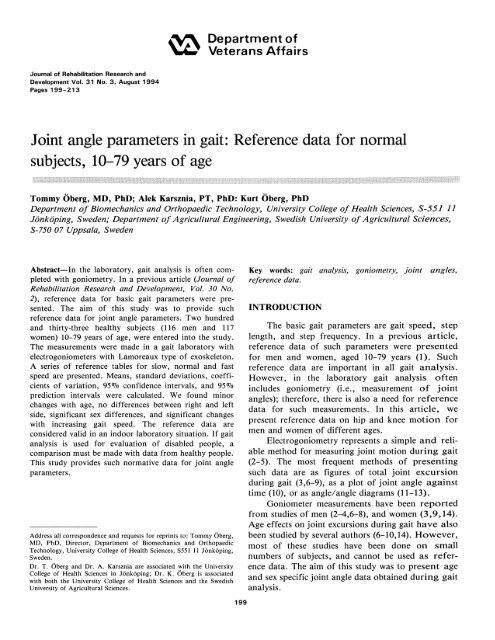

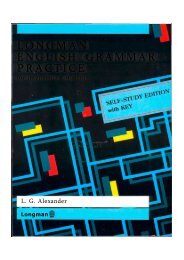

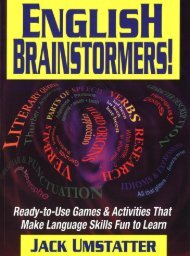
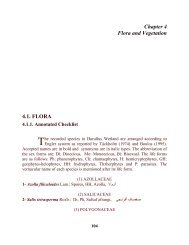

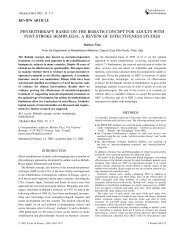
![Successful Ministry to the Retarded[ETowns] - Elmer Towns](https://img.yumpu.com/47721906/1/190x252/successful-ministry-to-the-retardedetowns-elmer-towns.jpg?quality=85)
